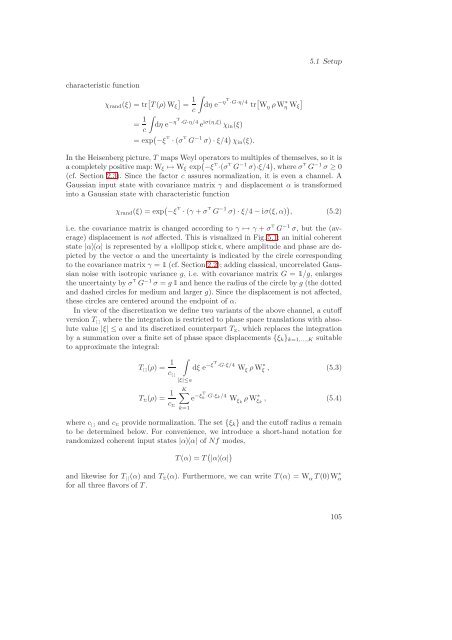Quantum Information Theory with Gaussian Systems
Quantum Information Theory with Gaussian Systems
Quantum Information Theory with Gaussian Systems
You also want an ePaper? Increase the reach of your titles
YUMPU automatically turns print PDFs into web optimized ePapers that Google loves.
characteristic function<br />
χrand(ξ) = tr <br />
1<br />
T(ρ)Wξ = dη e<br />
c<br />
−ηT ·G·η/4<br />
tr Wη ρ W ∗ η Wξ<br />
<br />
= 1<br />
<br />
dη e<br />
c<br />
−ηT ·G·η/4 iσ(η,ξ)<br />
e χin(ξ)<br />
= exp −ξ T<br />
· (σ T<br />
G −1 σ) · ξ/4 χin(ξ).<br />
5.1 Setup<br />
In the Heisenberg picture, T maps Weyl operators to multiples of themselves, so it is<br />
a completely positive map: Wξ ↦→ Wξ exp −ξ T ·(σ T G −1 σ)·ξ/4 , where σ T G −1 σ ≥ 0<br />
(cf. Section 2.3). Since the factor c assures normalization, it is even a channel. A<br />
<strong>Gaussian</strong> input state <strong>with</strong> covariance matrix γ and displacement α is transformed<br />
into a <strong>Gaussian</strong> state <strong>with</strong> characteristic function<br />
χrand(ξ) = exp −ξ T<br />
· (γ + σ T<br />
G −1 σ) · ξ/4 − iσ(ξ, α) , (5.2)<br />
i.e. the covariance matrix is changed according to γ ↦→ γ + σ T G −1 σ, but the (average)<br />
displacement is not affected. This is visualized in Fig. 5.1: an initial coherent<br />
state |α〉〈α| is represented by alollipop stick, where amplitude and phase are depicted<br />
by the vector α and the uncertainty is indicated by the circle corresponding<br />
to the covariance matrix γ = (cf. Section 2.2); adding classical, uncorrelated <strong>Gaussian</strong><br />
noise <strong>with</strong> isotropic variance g, i.e. <strong>with</strong> covariance matrix G = /g, enlarges<br />
the uncertainty by σ T G −1 σ = g and hence the radius of the circle by g (the dotted<br />
and dashed circles for medium and larger g). Since the displacement is not affected,<br />
these circles are centered around the endpoint of α.<br />
In view of the discretization we define two variants of the above channel, a cutoff<br />
version T [ ] where the integration is restricted to phase space translations <strong>with</strong> absolute<br />
value |ξ| ≤ a and its discretized counterpart T Σ, which replaces the integration<br />
by a summation over a finite set of phase space displacements {ξk}k=1,...,K suitable<br />
to approximate the integral:<br />
T [](ρ) = 1<br />
c [ ]<br />
T Σ(ρ) = 1<br />
c Σ<br />
<br />
|ξ|≤a<br />
K<br />
k=1<br />
dξ e −ξT ·G·ξ/4 Wξ ρ W ∗ ξ , (5.3)<br />
e −ξT k ·G·ξk/4<br />
Wξk ρ W∗ , (5.4)<br />
ξk<br />
where c [ ] and c Σ provide normalization. The set {ξk} and the cutoff radius a remain<br />
to be determined below. For convenience, we introduce a short-hand notation for<br />
randomized coherent input states |α〉〈α| of Nf modes,<br />
T(α) = T |α〉〈α| <br />
and likewise for T [ ](α) and T Σ(α). Furthermore, we can write T(α) = W α T(0)W ∗ α<br />
for all three flavors of T.<br />
105
















